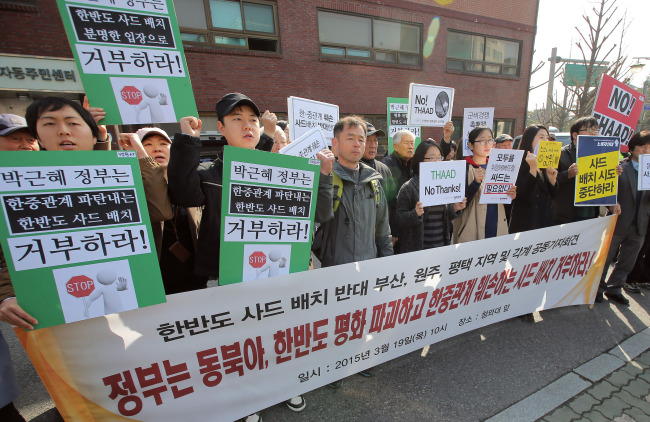Amid controversy over the U.S.’ potential deployment of an advanced missile defense battery here, defense experts are focusing on its military efficacy ― a topic that has been eclipsed by a dominant “U.S. vs China” discourse.
The experts say that the public debate should center on whether the Terminal High-Altitude Area Defense system would really be helpful or necessary to counter North Korea’s missile threats ― rather than on whose side Seoul should take amid objections from China and Russia.
Beijing and Moscow have explicitly presented their opposition to installing THAAD in Korea, arguing that the strategic U.S. military asset could mar the regional security balance, create military tension and potentially spark an arms race.
The experts say that the public debate should center on whether the Terminal High-Altitude Area Defense system would really be helpful or necessary to counter North Korea’s missile threats ― rather than on whose side Seoul should take amid objections from China and Russia.
Beijing and Moscow have explicitly presented their opposition to installing THAAD in Korea, arguing that the strategic U.S. military asset could mar the regional security balance, create military tension and potentially spark an arms race.

Those in favor of the THAAD deployment argue that the current missile defense programs employed by the U.S. Forces Korea and the South Korean military are insufficient to prepare against Pyongyang’s possible missile attacks.
The USFK has maintained the Patriot Advanced Capability-2 and PAC-3 interception systems at its bases in Osan and other locations. The two systems are designed to shoot down incoming missiles at altitudes of 10-15 km in the so-called “terminal phase” of flight.
The South Korean military which has only PAC-2 interceptors plans to purchase PAC-3 interceptors from the U.S. and upgrade the radar and launchers of its existing interception system. PAC-3 interceptors employing advanced “hit-to-kill” technology have stronger strike capabilities than the PAC-2 with fragmentation warheads.
With only PAC interceptors deployed here, military planners and experts have raised the need to establish a multiple-interception structure with the deployment of THAAD or other additional assets to intercept missiles at higher altitudes and boost chances of success. THAAD can incapacitate missiles at altitudes of 40-150 km.
But critics say that when the North has more than 1,000 missiles that could bring all South Korean targets within striking range, it would be impossible for any interception system to counter a massive attack. They argue that diplomatic losses from the deployment of THAAD may outweigh military benefits.
The North has deployed some 1,000 missiles that can strike the South: some 700 Scud-B and C missiles with ranges of 300-500 km and about 300 Rodong missiles with a range of around 1,300 km. Scud missiles are designed to strike South Korean targets. Rodong missiles can fly all the way to Japan, but can also target South Korea after adjustments to their operational range.
But proponents of THAAD argue that Seoul should secure defensive platforms to fend off missile threats to strategic military units to keep combat capabilities, even though those platforms might not be able to cope with massive missile strikes.
“Do we have to just sit and watch without doing anything just because THAAD or other assets can counter only limited missile attacks?” one military expert said, declining to be identified.
“We should secure at least the means to protect our strategic military bases against the enemy’s counterforce attacks (on military targets), even if we may not be able to fully protect some populated areas. That way, we can keep our warfighting capabilities, protect our citizens and send a signal that the missile salvo would only be futile.”
Some critics argue that since the North has many mobile launchers, called TEL (transporter erector launcher), it would be very difficult to detect its missile movements for interception purposes.
They also note the North could use deceptive mechanisms such as decoys to make it difficult to identify and strike the right warhead of a flying missile. Should the North use a missile capable of carrying multiple warheads, some of which could be fake payloads, it would also be difficult to accurately intercept the missile, they point out.
Another issue that critics have raised is that the Korean Peninsula is too small to employ any effective missile defense system. Missile experts say that it would take less than 4 minutes for a Scud missile to travel to Seoul.
Proponents of THAAD, however, argue that to maximize national security interests and defense capabilities, Seoul should devise whatever method is available.
“Even though it (THAAD) may not be as effective as we expect, it may be the starting point for us to improve our missile defense until we have perfect defense capabilities,” said Park Hwee-rhak, political science professor at Kookmin University.
“There are many people who want to highlight only the negative sides of this. But the question is what we should do to counter North Korean threats. We need to have an option. I would like to ask them what kind of options they have to protect South Koreans against North Korean threats.”
By Song Sang-ho (sshluck@heraldcorp.com)
-
Articles by Korea Herald



















![[Today’s K-pop] Treasure to publish magazine for debut anniversary](http://res.heraldm.com/phpwas/restmb_idxmake.php?idx=642&simg=/content/image/2024/07/26/20240726050551_0.jpg&u=)